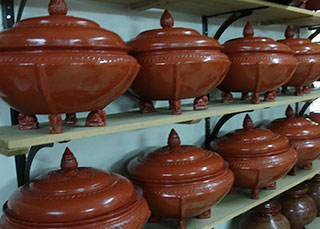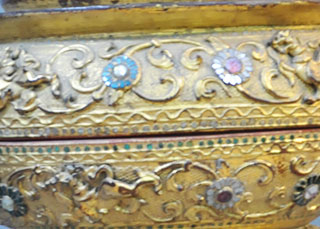Myanmar Lacquerware has a long tradition and the art of Lacquerware had existed mainly at Bagan. central part of Myanmar in 11th to 13th century A.D. Lacquer in Myanmar is called “Thitsi” meaning the sap of a Thitsi Tree (Melanhorrea Usitata) which is native to Southeast Asia. In China and Japan the tree from which lacquer is tapped is a different species “Rhus Vernicifera.” In Myanmar.the Thitsi tree grows wild in the Shan State and hilly regions. The resin of this tree has been extracted and used for coating and varnishing by Myanmar folks since time immemorial. A person who earns his living by the art of coating and varnishing with Thitsi is called “Thitsi thama”.
Bamboo and wood that are used as frame or base in making lacquerwork are easily and cheaply available around the Bagan area. Besides cowdung. saw dust and animal bone which are some of the ingredients used in the preparation of some lacquerwork are found in the countryside as Myanmar is an agricultural country.
Depending on the process and material used in the manufacturing process. the Lacquerware. it can be listed as follows:
Plain Lacquerware
Only Black and/or Red color is used. It comprises rice basket. boxes. chests to keep clothing or books. ceremonial bowl. tray and etc.


Incised Lacquerware
Many coatings of lacquer are applied to the frame (normally made of bamboo strips/bamboo yarn). The design and decoration are exquisite. Design and motifs are incised on the surface of the object with a fine iron stylus. The incised areas are filled with colors red. green. yellow etc. Folding Screen. tables. flower vases. ceremonial bowl. rice bowl. cups. plates. boxes. pickled tea leaves box. betel box. jewel box. etc. can be available with this incised Lacquerware.
Gilt Lacquerware
Incised designs and figures on the surface of the Lacquerware coated object are filled up with gold foil achieving an extremely regal beauty. In the olden days. this type of Lacquerware is reserved exclusively for royal use and or for offering to Buddhist shrines. Some walls or ceilings of some old temples are decorated with this type of Gilt Lacquerware.
Relief Lacquerware Figures and/or traditional designs made of a very sticky plaster which is a mixture of lacquer and ashes of animal bones. paddy husk and saw dust are stuck onto the lacquer coated surfaces of the object forming a relief on the designs already sketched out. Finally, coloring or gilding takes place after the plaster dries up.


Glass mosaic and gilt Lacquerware
Several shape of small pieces of mirror or color glass are inlaid in the surface of the Relief Lacquerware by applying special lacquer as adhesive.
